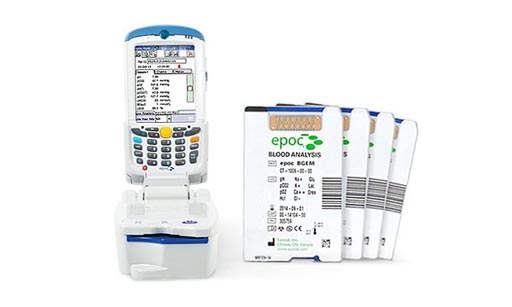Capillary Blood Analysis Validated for POC System
By LabMedica International staff writers
Posted on 22 Aug 2017
The gold standard samples for blood gas analysis are arterial blood collected from arterial catheter or by arterial puncture, but the proper sampling of arterial blood is difficult, painful, and sometimes risky to obtain in patient in transport.Posted on 22 Aug 2017
Capillary blood samples have become an alternative to arterial blood for blood gas and other critical tests especially in patient transport, because they are least painful and easiest to obtain, from various sites such as fingertip, heel or earlobe.

Image: The epoc POC blood analysis system (Photo courtesy of Alere).
Laboratory scientists at Baylor College of Medicine (Houston, TX, USA) used 10 venous blood samples to assess the correlation between reference methods and the capillary mode testing, which refers to collecting sample with the capillary tube provided followed by selecting “capillary” as the sample type on a Point of Care Blood Analysis System. Twenty three study participants (17 females, six males) were recruited to donate capillary blood for the reference range concordance study.
For method comparison of creatinine, fresh venous blood samples were collected and centrifuged within an hour from collection, and were tested on the predicate analyzer Vitros 5600 Integrated System. For method comparison of Na+, K+, Cl-, Ca2+, glucose, lactate, hematocrit, hemoglobin, pO2, pCO2, and pH, fresh venous blood samples were collected in heparinized vacutainer tubes, and were tested on the predicate analyzer GEM Premier 4000 with a minimum volume of 150 µL and on epoc Point of Care Blood Analysis System under the capillary mode.
The scientists found that acceptable correlations with other chemistry analyzers were found for all analytes except for ionized calcium. Accordance to the reference ranges of greater than 85% were observed with the exception of pO2 and chloride. Their data supports the implementation of the capillary blood tests on the epoc system with cautions needed for calcium. Chloride and pO2 tests are not suitable for capillary blood sampling.
The authors concluded that their study demonstrated that the epoc Point of Care Blood Analysis System may be one option of blood gas analyses and other critical tests using capillary blood in patient transport. The results are informative to institutions where pre-hospital and inter-hospital laboratory testing on capillary blood is a critical component of patient point of care testing. The study was available on line since July 19, 2017, on the journal Practical Laboratory Medicine.













